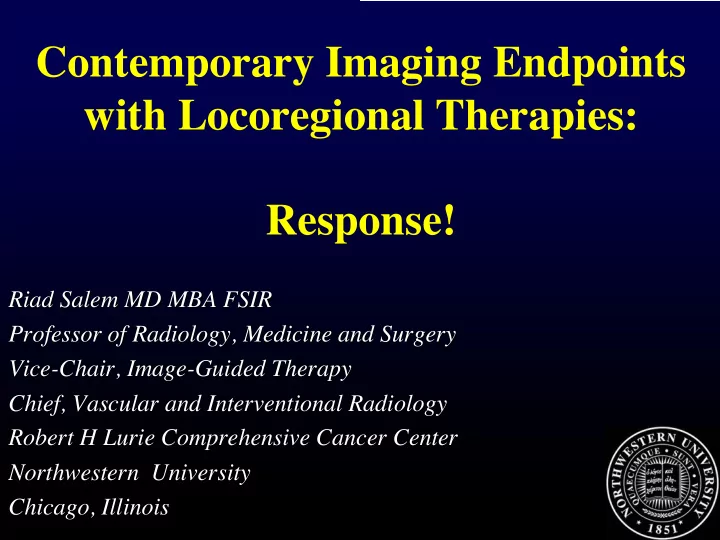

Contemporary Imaging Endpoints with Locoregional Therapies: Response! Riad Salem MD MBA FSIR Professor of Radiology, Medicine and Surgery Vice-Chair, Image-Guided Therapy Chief, Vascular and Interventional Radiology Robert H Lurie Comprehensive Cancer Center Northwestern University Chicago, Illinois
Disclosures Consultant Grant/Research Support • BTG UK Ltd • BTG UK Ltd • Boston Scientific • BMS • Dova Scientific Advisory Board • BTG UK Ltd • Cook • Eisai • Exelixis
Outline 1-Differentiating RECIST 1.1 and mRECIST response 2-Investigator review and central review differences -Why are outcomes different? 3-Making clinical decisions based on response
Point 1: Differentiating RECIST 1.1 and mRECIST
COMPETING METHODS OF ASSESSING RESPONSE 1. Uni-dimensional • Response Evaluation Criteria in Solid Tumors (RECIST) 2. Bi-dimensional • World Health Organization (WHO) 3. Volumetric 4. European Association for the Study of the Liver (2D EASL, mRECIST) 5. European Association for the Study of the Liver (3D EASL) 6. Functional Diffusion-Weighted (DW) MR Imaging (ADC)
• EASL (necrosis) Guidelines measure change in the amount of enhancing (viable) tissue only • Tissue Viability (Necrosis) – Assumes enhancement is tumor – Did not describe methods to measure necrosis – Qualitative observation Bruix et al J Hep 2001
• Number of tumors required to assess response decreased to: – Maximum of 5 – Maximum 2/organ Eisenhauer et al Eur J Cancer 2009
•Reviews and clarifies imaging methodology • New lesions • Portal vein thrombosis-non measurable • LN > 2 cm (malignant) • Pleural effusions/ascites • Retrospective adjudication of extrahepatic metastases Lencioni et al Semin Liver Dis 2010
mRECIST versus RECIST v1.1 mRECIST RECIST v1.1 Disappearance of any intratumoral arterial Complete response Disappearance of all target lesions enhancement in all target lesions Decrease of ≥ 30% in the sum of diameters of viable Decrease of ≥ 30% in the sum of diameters of target (enhancement in the arterial phase) target lesions, Partial response lesions, taking as reference the baseline sum of the taking as reference the baseline sum of the diameters of diameters of target lesions target lesions Increase of ≥ 20% in the sum of the diameters of viable Increase of ≥ 20% in the sum of the diameters of target (enhancing) target lesions, taking as reference the lesions, taking as reference the smallest sum of the Progressive disease smallest sum of the diameters of viable (enhancing) diameters of target lesions recorded since treatment target lesions recorded since treatment started started Eisenhauer et al Eur J Cancer 2009, Lencioni et al Sem Liv Dis 2010
Edeline et al Cancer 2011
Patterns of Progression-Enhancement-mRECIST
Patterns of Progression-Portal Vein Thrombosis
Point 2: Investigator review and central review differences Why are outcomes different?
Site versus Central review Central Review Site Review • Protocol training + charter • No protocol training • Specialist in liver MR/CT • May not be liver MR/CT specialized • Competency is tested • MD possibly biased • No MD bias • Aware of clinical circumstance • Blinded to clinical circumstance • Prospectively performed • Retrospectively performed • Influenced by patient care • Intended for statistical analyses and temporally unrelated to • Affects treatment decisions patient care • Per patient discordance in treatment-response finding • Reader reviews all patient scans • 2 nd , 3 rd reader à adjudication
Normal reader variability adjudication
Point 3: Making clinical decisions based on imaging Response matters!
Response versus Non Response: Interpret with caution 1-Survival analyses by simple R vs NR biases responders à Misinterpretation that response provides survival benefit 2-Guarantee-time bias à Better biology patients live longer and show R à Worse biology live insufficient time to show R, hence NR 3-Two methods to correct for this bias à Landmark-most commonly used à Mantel-Byar Anderson et al JCO 1983
Responder Non Responder
Landmark Analyses 1-Evaluates survival by tumor response 2-Addresses guarantee-time bias via the selection of fixed time points after treatment onset 3-Patients at the landmark time points are stratified by best response and survival analyses are performed 4-Patients who die before the landmark time point are excluded 5-Multivariate Cox regression models with OR as a time- dependent covariate -Adjusts OS outcome corrected for confounding factors (liver function, burden)
-guarantee/immortal-time bias Memon et al Gastroenterology 2011, Lencioni et al JHEP 2017, Meyer et al Liv Int 2017, Kudo et al ASCO 2018
• Time-dependent Analysis • Landmark Analyses confirm responders>non responders Kudo et al ASCO GI 2019
Why does response matter? Related to PFS -for any given PFS, highest RR yields lowest tumor burden D OS Lethal tumor load Tumor load at Baseline - 30% PFS +20% from nadir Tumor nadir Time since start of treatment
PFS surrogate of survival Llovet et al JHEP 2019
Conclusions • mRECIST favored over RECIST 1.1 in HCC • Site vs central read will show differences • Landmark analyses critical when assessing R vs NR survival • For any given PFS, better RR beneficial for patient • PFS as potential surrogates • With advent of IO, response (and duration) has become prime endpoint of interest
Recommend
More recommend